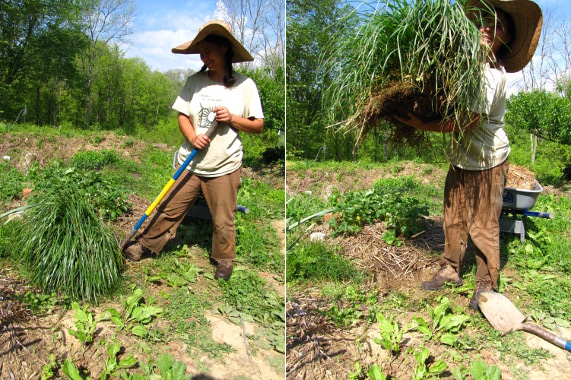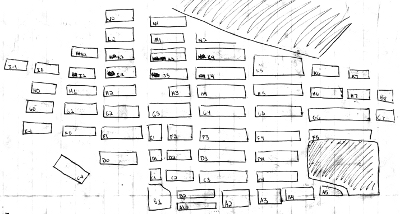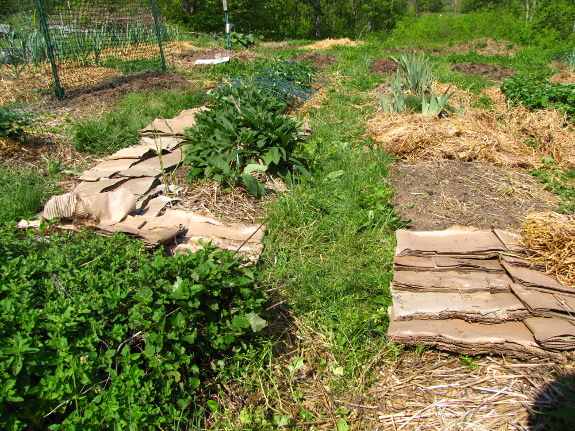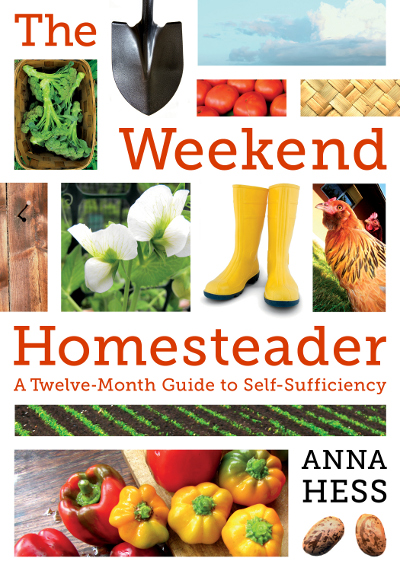
Streamlining grassy garden aisles

The saying that you
spend 90% of your time carrying out 10% of the tasks in an average job
is true in the garden too. Taking a few minutes to root out
inefficiencies really pays off, even though it seems hard to budget the
hours when putting in your spring garden.
This year, we've been
focusing on making it easier to mow
the garden aisles. Clumps of tall
fescue, like the one
I'm digging out in the top photos, bog down the mower and take several
extra seconds (and quite a bit of brute force) to trim down. It
doesn't sound like much, but once you've hit ten clumps of fescue, the
time (and hassle) adds up. We're slowly but surely rooting out
these problem grasses, leaving the more well-behaved bluegrass
and white clover to
take their place.

 Meanwhile, I'm also slowly
fixing the crazy quilt of a front garden, parts of which I hand-dug
during our first couple of years on the farm. At the time, I'd
never worked in a garden with permanent beds, so I assumed lots of
cross aisles would make my job easier. The truth is, I almost
never walk down those cross aisles, and it's very tough to maneuver the
mower around to cut the grass in them. (It would be a bit easier
if my aisles were wider like in the mule garden.)
Meanwhile, I'm also slowly
fixing the crazy quilt of a front garden, parts of which I hand-dug
during our first couple of years on the farm. At the time, I'd
never worked in a garden with permanent beds, so I assumed lots of
cross aisles would make my job easier. The truth is, I almost
never walk down those cross aisles, and it's very tough to maneuver the
mower around to cut the grass in them. (It would be a bit easier
if my aisles were wider like in the mule garden.)

So I'm spending a few
extra minutes to lay down a kill mulch and turn the cross-aisles into
part of long, linear beds. This year, I'll just let the grass die
back under the cardboard, then this fall I'll plant an oat cover crop
to start building the soil up in these new garden spots. I  figure by next year, I'll be
able to plant vegetables, increasing my growing area while also making
the garden easier to maintain.
figure by next year, I'll be
able to plant vegetables, increasing my growing area while also making
the garden easier to maintain.
The only slight
disadvantage of my bed merger is that now I'm going to have to add
decimals to my numbering scheme. It already has negative numbers
--- how geeky can you get?
Weekend
Homesteader: May contains a whole chapter on tricks for planning an
ergonomic garden. The chapter has been expanded and moved to
April in my new
paperback.
Want more in-depth information? Browse through our books.
Or explore more posts by date or by subject.
About us: Anna Hess and Mark Hamilton spent over a decade living self-sufficiently in the mountains of Virginia before moving north to start over from scratch in the foothills of Ohio. They've experimented with permaculture, no-till gardening, trailersteading, home-based microbusinesses and much more, writing about their adventures in both blogs and books.
Want to be notified when new comments are posted on this page? Click on the RSS button after you add a comment to subscribe to the comment feed, or simply check the box beside "email replies to me" while writing your comment.

So, putting down a thick kill mulch now and seeding one round of oats should yield enough biodegraded material in which to plant next spring? Or do you plan on doing more than one planting?
~ Mitsy
Mitsy --- It totally depends on the quality of your soil. This is in the high quality soil of the front garden, so I could plant directly into a kill mulch there as soon as the grass is dead, as long as I added some compost to counterbalance the carbon of the decomposing weeds. But since I don't need that space yet, I'll just wait.
The oat cover crop will be providing additional organic matter to the soil, but not much nitrogen. So, if you're following my lead, be sure to still apply plenty of manure and/or compost in the spring before planting!
Huh. Numbers. Who'd uv thunk. I use letters, A, B, C, D and then have little key codes as to what is going in which bed in combo. Maybe a better way to do it is to name it like we name our computers, and wireless routers, and server etc.
Or after shakespearean names. Or... anything NOT plant related.
So in Bob I'm putting tomatoes this year, and in Fred I'm planting my carrots and onions. I can see fun here....
Aha! That's because you have more than a handful of beds. I have 8.
I have 8.  It would work with mine but you're absolutely right, at that size...
It would work with mine but you're absolutely right, at that size...
Do you also think in North South East West directions? I'm one of the only women I know who does in my generation. My dad used to give directions to find a hammer or a particular drill bit this way "West side of pole barn, 3rd bay from the north, bottom right side." And the item was always there. I have names for the bedrooms in my house "west room" "south west room" it drives my husband crazy.